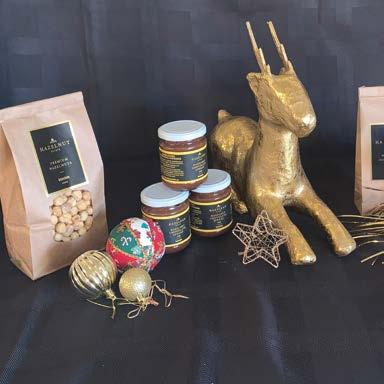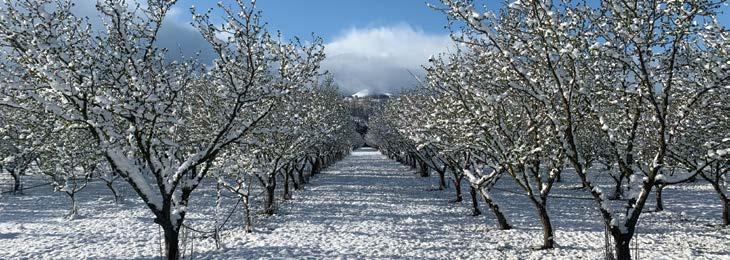
7 minute read
Hazelnut harvest full of potential
FEATURE
ARTICLE
Janine and Roger Southby in their hazelnut orchard at East Taieri, south of Dunedin
On the fertile soils of the Taieri Plains lies a fruitful hazelnut orchard run by the Southby family. HELENA O’NEILL talks to Roger and Janine Southby bout their quest to provide premium hazelnuts for the local market.
Hazelnut Estate is a 5.8-ha orchard located at East Taieri, south of Dunedin. The Southby family bought the property at the end of February 2020, just weeks before the country was plunged into the first national Covid-19 lockdown.
The orchard is home to about 4700 hazelnut trees, mostly Whiteheart, with a small portion of other varieties to allow wind pollination. “We do everything on-site: from the tree to the gate,” Janine says. “We’ve really benefitted from both previous owners’ foresight. The guy we bought the property from did a little bit of small-scale selling, stopping a year or two before he sold. “We created a new label under Hazelnut Estate, and we can process it all the way through.” The couple is proud to run a spray-free orchard and work hard to ensure the hazelnut trees are properly nurtured and maintained, all with the mission of growing great hazelnuts. “In the processing shed, there is a separate commercial kitchen,” Roger says. “We can do all the roasting and preparation of the hazelnut chocolate spread and the flour in that commercial kitchen.
“Instead of ‘paddock to plate’ we call it ‘tree to table’. Controlling that whole process and knowing that there are no additives, herbicides and fungicides going into the nuts.”
A mere five months after buying the orchard, the Southbys were selling their hazelnuts under the Hazelnut Estate banner, mostly at the local farmers’ market. Hazelnut Estate primarily sells dry roasted nuts, hazelnut chocolate spread, hazelnut flour and a small number of raw nuts.
“The previous owner used to sell at the Otago Farmers’ Market [in Dunedin]. We contacted the market’s management and asked if they would have us back in… that gave us a little bit of surety to know there is an existing market to enter,” Roger says. “We do love it. I think it’s when you get to engage with the customer knowing that you have been responsible for the growing of the nut, the processing and the packaging, and the establishment of your own label. You’re also communicating with the end user; you can answer their questions and give them the information that they need. That’s really satisfying for me.” Since then, they have developed a website allowing for a small number of online sales, along with attending special community markets around the lower South Island.

Running an orchard without any prior horticulture experience offers its own share of challenges — Janine is an intermediate schoolteacher and Roger is a programme manager at Otago Polytechnic’s institute of sport and adventure. Growing and harvesting aren’t too laborious, Roger says, but processing the nuts is another story.
“It is a labour-intensive process and to fully automate that, you would need to be on the scale of growers in Italy or Oregon [in the United States] where you have hundreds of acres planted in nuts. There’s no one like that in New Zealand.”
Buying an existing orchard came with a requirement to develop new skills, particularly pruning. “One of the problems that we faced when we purchased the orchard was that the trees hadn’t been pruned properly for eight or nine years. So, the yield on the trees is not what it should be,” Roger says. “The first harvest was down to about six-and-a-half tonnes.
“We’ve had to prune quite hard on the trees. There’s quite a small pruning window in the middle of winter, and for the past couple I have been injured and at a limited capacity. “That’s one of our goals: to get the pruning throughout the whole orchard and get that tree health and yield back up again.” Roger says that while they do ‘feed the trees,’ they don’t use sprays and don’t have many issues with pests and diseases. “They do seem quite a resilient tree, we don’t seem to have too many issues.” Sheep keep the grass down from post-harvest until about November when a mower is used instead. Grass needs to be kept under control in order for the harvester to work properly. The harvest season usually runs from late March to late April. “We try to do two runs through the orchard. When about 70 to 80 percent of the nuts have fallen off the tree, we will put the harvester through the orchard. Then we will monitor the rest of the trees for when the rest of the nuts have fallen, generally within the next two to three weeks.” Nuts are sorted, placed on drying racks, and turned daily until the moisture content is around six percent. They are roasted on-site, although a small amount is left raw, and are then either packaged up or processed into hazelnut flour or hazelnut chocolate spread. With three harvest seasons under their belt, the couple have grown in confidence and pride in their produce. “The taste of a freshly roasted nut of the Whiteheart is really, really good. They do roast well, which makes the removal of the skin relatively easy. That’s the biggest advantage, the quality of the nut,” Roger says. Janine says Whiteheart is one of the main varieties in New Zealand because it does well in lots of different climates.
According to the Hazelnut Growers’ Association of New Zealand (HGANZ), Whiteheart was selected from a group of old varieties and seedling selections by Professor

A spring cold snap left the orchard looking picturesque in early October
Maxine Thompson of Oregon State University during her 1981 visit. The variety became widely recommended after it performed well in a Lincoln University hazelnut trial. It has been promoted because it is seen as offering a quality advantage – specifically, a round clean kernel that blanches 100 percent over Turkish or Italian kernel varieties. It does still have its complexities however, such as vigorous suckering, late flowering, being susceptible to big bud mites and bacterial blight. It also does not yield well in some orchards.
Janine says the association has been an excellent source of information about hazelnuts, from learning the industry’s history, to troubleshooting when something goes wrong or finding out about best practice. “It’s certainly been positive [experience] with the Hazelnut Growers’ Association. Especially the willingness of people who have been in the industry for a long time, particularly up North Canterbury way,” Janine says. “They have been really willing to share and help us out whenever we’ve been a little bit puzzled about anything or at a loss.” Roger says most hazelnut growers are lifestyle or hobby orchardists, but there is scope for the development of New Zealand’s commercial hazelnut industry. “We had a presentation through the association and I think domestic production is around two percent of annual consumption. That’s one of the problems that the industry does face. Most people’s perception of hazelnuts is storebought, imported nuts that could be six to eight months old, not fresh, and they think hazelnuts aren’t great. But when they taste a fresh hazelnut grown in New Zealand, it’s remarkable the feedback we have been getting. People are amazed.”
The Southbys’ operation is currently coordinated around the couple’s two full-time jobs, but the grand plan is to make the hazelnut operation more profitable in future and reduce time at their other jobs. “We’re in that real balancing act to getting the business to the next level when we need to spend more time on it, but at the moment it’s not generating enough money so we both have to be working full-time. It’s our next focus over the next six months or so, how we get to that stage and what do we do to get there,” Roger says. “We think that we have a great product: the feedback to date is that everyone loves the product. It’s just a matter of getting that message out there more and growing our business.”
A GEM FOR AGPRO NZ
Chariot™ Insecticide
AGPRO NZ will be the product distributors of Chariot Insecticide from December 2022 says Mark Freeman of AGPRO NZ.
Chariot contains 120g/l Spinosad and is a welcome addition to our range for our existing vegetable clients and we look forward to supplying Avocado, Citrus, Vineyards, Kiwifruit and Pipfruit growers with this chemistry. Spinosad was first approved here in 1998 to control a selected range of insects in fresh vegetables for both domestic and export sale. It has a unique mode of action and controls pest species that are resistant to conventional insecticides. Being a group 5 insecticide no more than 4 applications should be made to any crop in one season. Crop monitoring for pest thresholds and the applications, are thus very important.
09 273 3456 www.agpro.co.nz
Active Ingredient: Contains 120 g/litre Spinosad in the form of a suspension concentrate. Registered pursuant to ACVM Act 1997 No. P9937 Distributed by: AGPRO NZ Ltd 10 Polaris Place, East Tamaki, Auckland Registered to: Renovo Technologies Ltd 4 Swans Road, Bell Block, New Plymouth Tel: 06 927 3025










